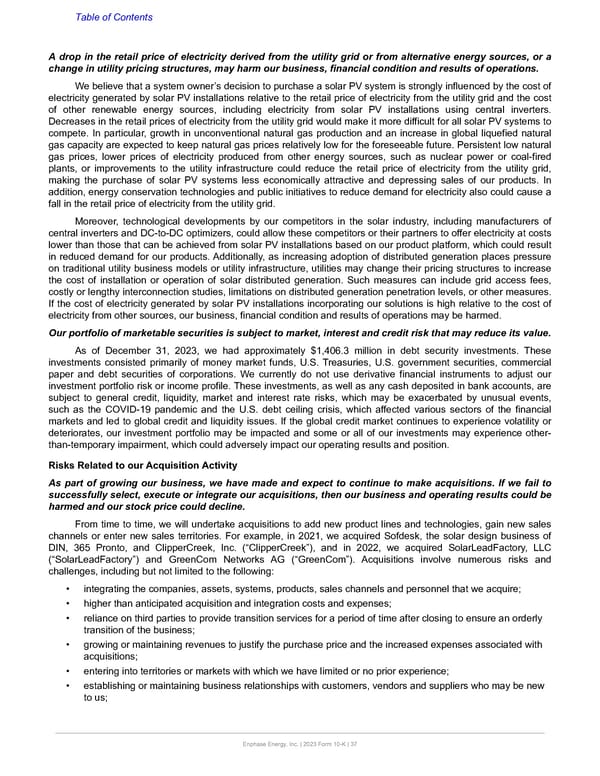Table of Contents A drop in the retail price of electricity derived from the utility grid or from alternative energy sources, or a change in utility pricing structures, may harm our business, financial condition and results of operations. We believe that a system owner’s decision to purchase a solar PV system is strongly influenced by the cost of electricity generated by solar PV installations relative to the retail price of electricity from the utility grid and the cost of other renewable energy sources, including electricity from solar PV installations using central inverters. Decreases in the retail prices of electricity from the utility grid would make it more difficult for all solar PV systems to compete. In particular, growth in unconventional natural gas production and an increase in global liquefied natural gas capacity are expected to keep natural gas prices relatively low for the foreseeable future. Persistent low natural gas prices, lower prices of electricity produced from other energy sources, such as nuclear power or coal-fired plants, or improvements to the utility infrastructure could reduce the retail price of electricity from the utility grid, making the purchase of solar PV systems less economically attractive and depressing sales of our products. In addition, energy conservation technologies and public initiatives to reduce demand for electricity also could cause a fall in the retail price of electricity from the utility grid. Moreover, technological developments by our competitors in the solar industry, including manufacturers of central inverters and DC-to-DC optimizers, could allow these competitors or their partners to offer electricity at costs lower than those that can be achieved from solar PV installations based on our product platform, which could result in reduced demand for our products. Additionally, as increasing adoption of distributed generation places pressure on traditional utility business models or utility infrastructure, utilities may change their pricing structures to increase the cost of installation or operation of solar distributed generation. Such measures can include grid access fees, costly or lengthy interconnection studies, limitations on distributed generation penetration levels, or other measures. If the cost of electricity generated by solar PV installations incorporating our solutions is high relative to the cost of electricity from other sources, our business, financial condition and results of operations may be harmed. Our portfolio of marketable securities is subject to market, interest and credit risk that may reduce its value. As of December 31, 2023, we had approximately $1,406.3 million in debt security investments. These investments consisted primarily of money market funds, U.S. Treasuries, U.S. government securities, commercial paper and debt securities of corporations. We currently do not use derivative financial instruments to adjust our investment portfolio risk or income profile. These investments, as well as any cash deposited in bank accounts, are subject to general credit, liquidity, market and interest rate risks, which may be exacerbated by unusual events, such as the COVID-19 pandemic and the U.S. debt ceiling crisis, which affected various sectors of the financial markets and led to global credit and liquidity issues. If the global credit market continues to experience volatility or deteriorates, our investment portfolio may be impacted and some or all of our investments may experience other- than-temporary impairment, which could adversely impact our operating results and position. Risks Related to our Acquisition Activity As part of growing our business, we have made and expect to continue to make acquisitions. If we fail to successfully select, execute or integrate our acquisitions, then our business and operating results could be harmed and our stock price could decline. From time to time, we will undertake acquisitions to add new product lines and technologies, gain new sales channels or enter new sales territories. For example, in 2021, we acquired Sofdesk, the solar design business of DIN, 365 Pronto, and ClipperCreek, Inc. (“ClipperCreek”), and in 2022, we acquired SolarLeadFactory, LLC (“SolarLeadFactory”) and GreenCom Networks AG (“GreenCom”). Acquisitions involve numerous risks and challenges, including but not limited to the following: • integrating the companies, assets, systems, products, sales channels and personnel that we acquire; • higher than anticipated acquisition and integration costs and expenses; • reliance on third parties to provide transition services for a period of time after closing to ensure an orderly transition of the business; • growing or maintaining revenues to justify the purchase price and the increased expenses associated with acquisitions; • entering into territories or markets with which we have limited or no prior experience; • establishing or maintaining business relationships with customers, vendors and suppliers who may be new to us; Enphase Energy, Inc. | 2023 Form 10-K | 37
 Annual Report Page 36 Page 38
Annual Report Page 36 Page 38